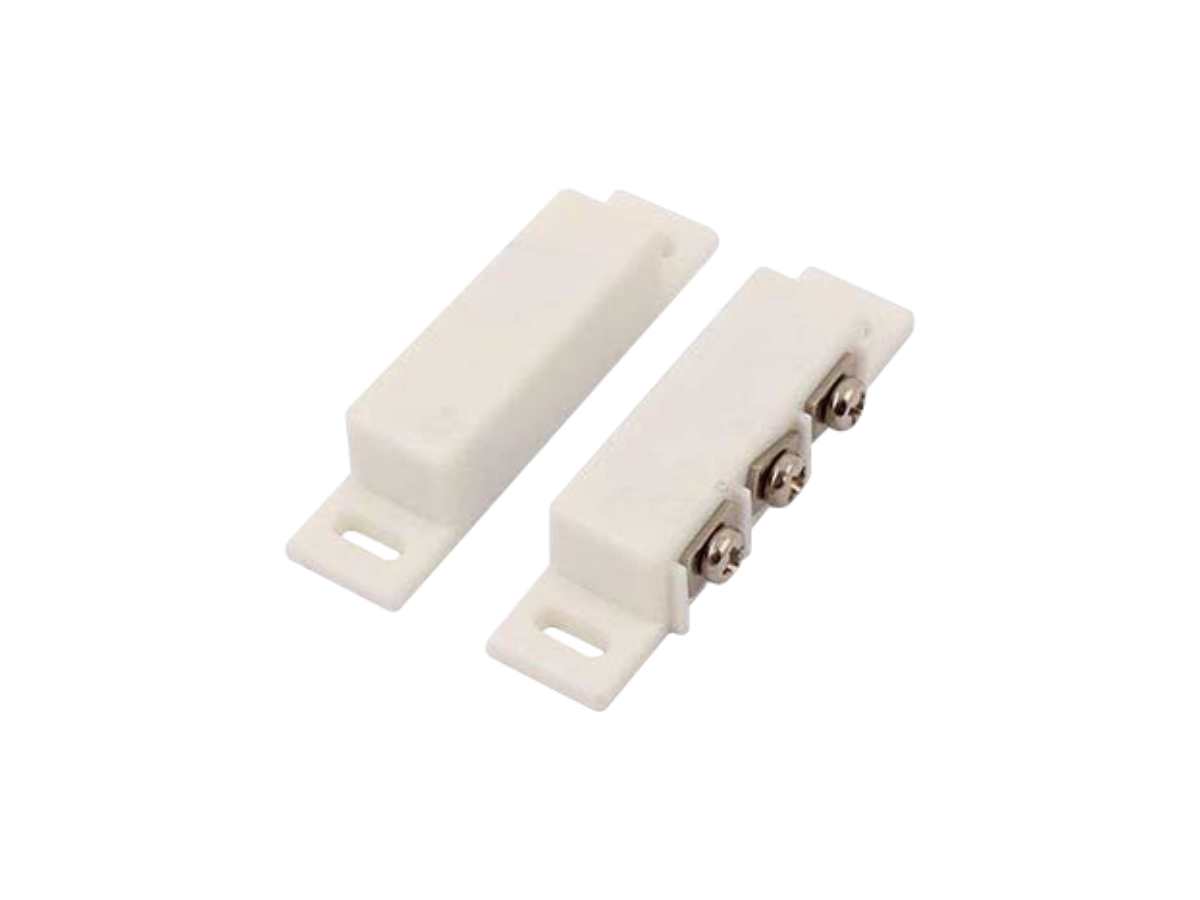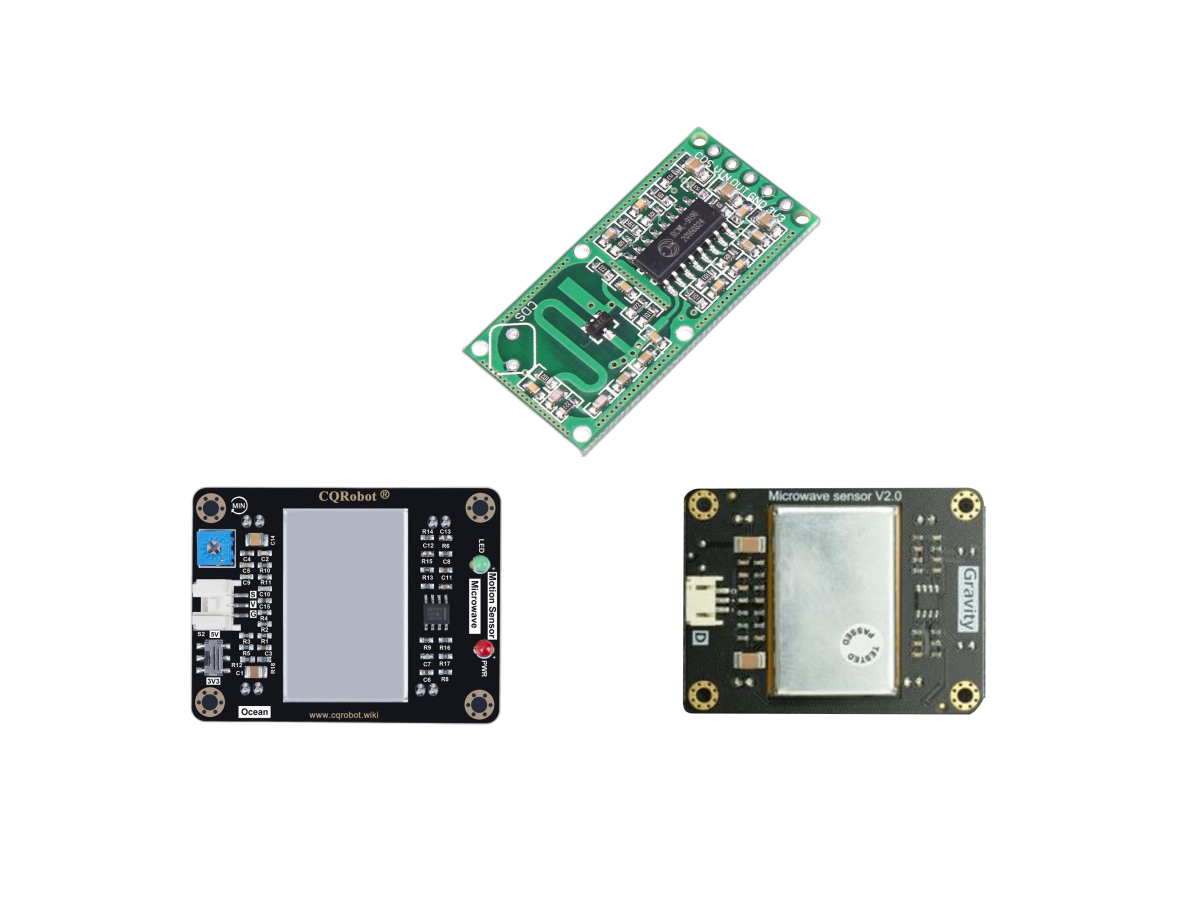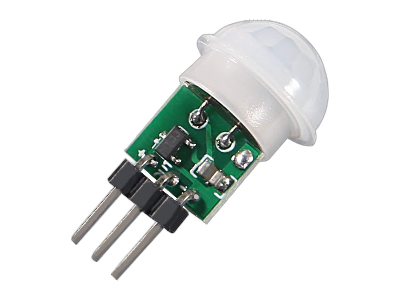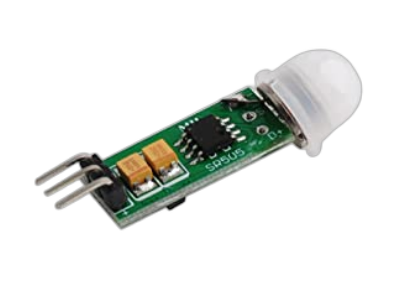PIR Sensor Modules
Updated: 25Aug2024 03:28:52 UTC 2024-08-25T03:28:52Z
Rating: (0 reviewsThis article has not been rated yet)
Passive Infrared (PIRPassive Infrared) sensors are able to detect motion from a thermally radiating body, such as a human or animal, within the proximity of the sensor. They are often used in outdoor lighting, security systems, home automation, and other proximity-sensing applications.
This overview of PIR sensors will cover the most common modules, how they operate, and their capabilities.
Operation
PIR modules typically have a plastic Fresnel lens that focuses the IRInfrared radiation from a moving thermal body onto a pyroelectric sensor which generates a small signal that gets amplified and thresholded to produce a digital output signal. A diagram of the basic operation of a PIR sensor is shown below.
Some common terms that when describing the characteristics of PIR modules are given below.
- Operating Voltage:
- The operating voltage across VCC and GND provides power to the PIR sensor module for the components in the circuitry. PIR modules typically accept a range of voltages with onboard regulator IC that steps down and stabilizes the voltage for the circuit components.
- Output Voltage:
- The output signal voltage is typically an active HIGH 3.3V or 5V when motion is detected. When no motion is detected, the output is a LOW 0V.
- Quiescent Current:
- This is the current consumption of the PIR module when it is not actively detecting motion. The PIR modules mentioned here are low power devices with a quiescent current on the order of microamps. This makes them useful for battery applications.
- Sensing Angle:
- This is the Field-Of-View (FOV) of the sensor specified in degrees that is typically around 100° to 120°.
- Sensitivity or Sensing Range:
- The sensitivity of PIR modules determines the sensing range distance of how far from the sensor they can detect motion. PIR modules typically range from 3m up to 7m (9ft up to 21ft), where on some modules this can be adjusted using a potentiometer.
- Delay Time:
- The delay time is how long in seconds the output will remain HIGH after motion is detected.
- Blocking Time:
- PIR modules can have a period of time after a detection, called a blocking time, where it blocks any more detections. During the blocking time the PIR module circuitry does not accept any signal from the sensor. This helps inhibit interference or noise that produce false positives. Some PIR modules have an adjustable blocking time that can be set from zero to tens of seconds.
- Trigger Mode:
- A repeatable trigger output mode, sometimes called multiple trigger mode, means that after a detection when the output turns high any new detections during the delay time will restart the delay time. A non-repeatable trigger mode, sometimes called a single trigger mode, means that after a detection when the output turns high it will remain that way by blocking any new detections until the delay time is over.
Modules
There are several PIR modules available with different operating voltages, sensitivities, and output signals when motion is detected. A comparison of the most common PIR modules are listed in the table below.
| Model | AM312 | HC-SR501 | HC-SR505 | MH-SR602 | SparkFun OpenPIR |
|---|---|---|---|---|---|
| Operating Voltage | 2.7V-12V DC | 4.5V-20V DC | 4.5V-20V DC | 3.3V-15V DC | 3V-5.75V DC |
|
Output Voltage (High/Low) |
5V / 0V | 3.3V / 0V | 3.3V / 0V | 3.3V / 0V | (3V - 5.75V) / 0V or Analog |
| Quiescent Current | < 20μA | < 50μA | < 60μA | < 20μA | < 80μA |
| Sensing Angle | ≤ 100° | < 120° | < 100° | < 120° | < 100° |
| Sensing Range | 3m - 5m | 3m - 7m | 3m | 5m | 2m - 5m (adjustable) |
| Delay Time | 2s | 5s - 18s (adjustable) |
8s ± 30% | 2.5s | 0.4s - 7.5s (adjustable) |
| Blocking Time | 2s | 2.5s | 2.5s | 2s | N/A |
| Trigger Mode | Repeatable | Repeatable / Non-Repeatable |
Repeatable | Repeatable | Repeatable / Non-Repeatable |
| Operating Temperature |
-20°C to +60°C | -20°C to +80°C | -20°C to +80°C | -20°C to +80°C | -20°C to +80°C |
AM312
The AM312 shown below is a miniature PIR module in a compact form factor with an approximate size of 12mm x 25mm.
This sensor is optimized for small size and low power consumption (12μA min, 15μA typical, and 20μA max) for battery operated applications compared to other PIR Sensors. It also has a wide operating voltage range of 2.7V to 12V DC, making it compatible with either 3.3V or 5V microcontrollers.
This module has three connection pins: VCC, Output, and GND. The output is a Repeatable Trigger where the sensor output will remain high after the delay period if there is still human activity still in its sensing range.
HC-SR501
The HC-SR501 PIR module shown below has a small size of 24.03mm x 32.34mm x 24.66mm (LxWxH with lens). The HC-SR501 distinguishes itself from other modules on here with a sensing range of up 7m that is adjustable with a sensitivity potentiometer.
This module operates on 4.5V to 12V power for the onboard regulator and the board includes a reverse polarity protection diode (in case the VCC and GND are swapped). The output is a digital signal with 3.3V HIGH and 0V LOW.
The bottom side of the HC-SR501 PIR module is shown below.
The sensitivity potentiometer on the side of the board allows you to set the maximum detection range from 3m to 7m. The Time-Delay potentiometer allows you to set how long the output will remain HIGH after motion is detected.
The board comes with a berg jumper that allows you to choose one of two trigger modes: L for Single Trigger and H for Multiple Trigger. In both modes, the output goes HIGH as soon as motion is detected and remains HIGH for a period determined by the Time-Delay potentiometer. In Single Trigger Mode (L), further detection is blocked until the output returns to LOW at the end of the time delay. In Multiple Trigger Mode (H), the time delay is reset each time motion is detected.
HC-SR505
The HC-SR505 PIR sensor module comes in a small package (44mm x 11mm), a sensing range up to 3m, and a wide operating voltage range of 4.5V to 20V DC.
The output is a repeatable trigger mode. The output goes HIGH when motion is detected for approximately 6-12 seconds then returns LOW. If motion continues within the sensor range, the module will continue to keep the output HIGH until the motion stops for at least 6-12 seconds.
Compared to the HC-SR501, the HC-SR505 can easily be triggered by changes in room temperature or by noise on the power supply.
MH-SR602
The MH-SR602 is a very small version of a PIR sensor with a size of 19.6mm x 16mm (LxW) including the pins and lens. It also has a wide operating voltage range of 3.3V to 15V DC, making it compatible with either 3.3V or 5V microcontrollers.
The output is an active 3.3V High and 0V Low with a Repeatable Trigger where the sensor output will remain high after the delay period if there is still human activity in its sensing range. The S+ and S- pin holes on the side of the board is an option to solder on a photodiode (cannot be an LDRLight Dependent Resistor), so it will only work at night.
You can modify the sensitivity and delay time by soldering resistors on the back side of the board.
The default sensitivity resistor is 0Ω to give a maximum sensitivity at a range of 5m (increasing the resistance will reduce the sensitivity and range). The default delay time resistor is also 0Ω that gives the lowest delay time of 2.5s, but can be increased up to about one hour by soldering on a higher resistor.
SparkFun OpenPIR
The SparkFun SEN-13968 OpenPIR is a PIR sensor based on the NCS36000 PIR Controller IC with both a digital and analog output. This board has an adjustable sensitivity range up to 5m (16ft) and an adjustable length of time the output remains high using potentiometers.
The voltage supply range is 3V to 5.75V DC, making it compatible with either 3.3V or 5V microcontrollers. There is also a motion activity indicator LED on front of board that illuminates during start-up mode and when motion is detected.
The bottom side SparkFun OpenPIR board is shown below followed by a description table. The power and output pins are broken out into two rows, where the top row (closest to the lens) is for a 4-pin JST PH connector and the bottom row is a standard 0.1in header.
| Feature | Description |
|---|---|
| VCC & GND | The voltage supply range is 3V to 5.75V DC, making it compatible with either 3.3V or 5V microcontrollers. |
| OUT | The OUT pin provides an active high digital signal when motion is detected. |
| A Pin | The A pin is the amplified PIR analog output signal when motion is detected before it is sent to a window comparator in the NCS36000 to convert it into a digital signal for the OUT pin. |
| Trigger Mode Switch | The trigger mode switch allows you choose between two motion detection modes: single-pulse and dual-pulse. Single-pulse mode is used to detect an object entering or exiting the PIR's FOV, while dual-pulse detection is used to detect when an object enters and then leaves the view area. |
| Sensitivity Trimpot | The sensitivity trimpot labeled SEN can be used to adjust the view distance of the OpenPIR with a maximum sensitivity of about 5m (16ft). |
| OSC Trimpot | The NCS36000 oscillator frequency trimpot labeled OSC controls the length of time the output remains HIGH between 400ms to 7.5s. |
| xLED Jumper | The onboard LED consumes about 3mA and can be disabled by removing the solder and opening the xLED jumper. |
SparkFun has more info on their OpenPIR module in the following links.









(0) Comments
Sign in to leave a comment
Sign In